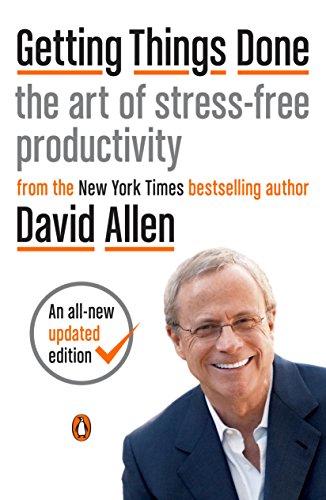(This is one of a series of posts about productivity books and the lessons I took from them. The series is: Getting Things Done, A Sense of Urgency, and The ONE Thing.)
Being productive doesn’t mean you have to sacrifice. A to do list doesn’t mean you can’t be spontaneous.
It is possible to be effectively doing while you are delightfully being, in your ordinary workaday world.
Getting Things Done lays out an effective system for managing your work and all of the tasks and emails that entails.
The Problem
Mental to do lists occupy brain space that could be used in more creative or productive fashions.
The clutter of mental to do lists creates stress. There is even stress in trying not to forget something. And often your mind only reminds you about something the next time you come across it at which point you likely put it off again.
It is a waste of time and energy to keep thinking about something that you make no progress on.
The System
Stop storing task lists in your mind.
Find a place to write down each and every thing you need to do (from high level stuff at work down to needing new batteries for the flashlight) in one place. That place could be a notepad, a spreadsheet, or task management software such as Asana. Commit to that one place.
Once you have a collection of tasks then you need to go through them and organize them. For each task:
- Ask yourself if it is actionable.
- If it is not actionable then either trash it or file it away for later reference.
- If it is actionable then do it if it takes less than two minutes.
- Otherwise either delegate it or defer it by creating an entry on your calendar for it.
Do It, Delegate It, or Defer It.
Never return an item back into your inbox.
(For Asana I consider the “New Tasks” section the collection place and anything that is deferred is marked for Today, Upcoming, or Later with a date set for tasks needing to be completed on a certain date rather than by a certain date.)
Projects
Breakdown larger projects into small steps as a project isn’t actionable in and of itself. The individual steps are actionable. Keep all of the supporting reference material for the project somewhere other than the to do list. Ideally keep it out of sight so it will be out of mind except when you’re working on the actionable steps.
When planning projects first ask yourself what the purpose of the project is. Doing so will define what the criteria for success is, allow you to focus resources, and provides motivation.
Next brainstorm all of the steps needed to complete the project. Organize the steps. Begin work on the actionable steps or assign resources to them.
The Getting Things Done system works great for email and is probably the quickest way to get to inbox zero short of dragging all of your email into the trash. The book recommends creating a folder specifically for emails you have deferred as well as a second folder for emails you’ve delegated to others and are awaiting confirmation of the outcome on.
My inbox has actually been the largest benefactor of this system as I, like most of the working world, receive most of my business communication via email. Turning those emails into tasks or calendar items gets them out of my inbox and eliminates the feeling of being overwhelmed I used to have every morning when I would open Outlook.
I would, and have, recommend this book to pretty much anybody as freeing the mind from remembering tasks allows one focus on the larger projects that move businesses forward. It also allows one to enjoy their free time more knowing that there is nothing for them to forget as they’ve already written it down.

